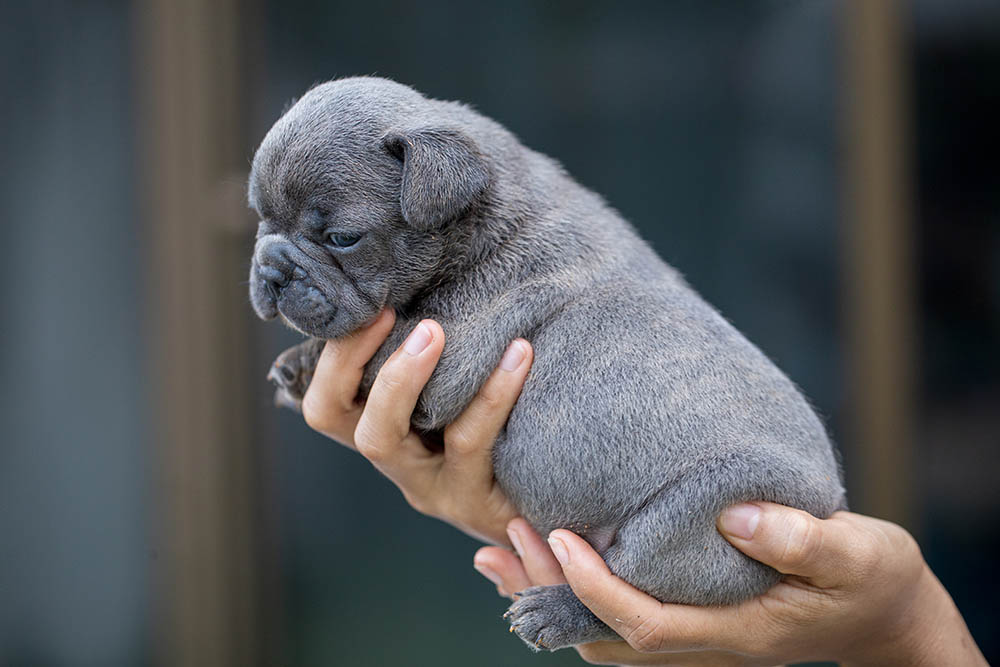Click to Skip Ahead
Blue Frenchies are charming, fun, and have become one of the most popular dog breeds in America. They have a friendly temperament and casual laid-back attitude. Today there are more Blue French Bulldogs registered with the American Kennel Club than ever before, and their numbers are growing more and more every year.
Breed Overview
Height:
Small to medium (11 – 12 inches)
Weight:
20 – 28 pounds for males, 16-24 pounds for females
Lifespan:
10 – 12 years
Colors:
Fawn, fawn and white, fawn brindle, brindle, brindle and white, cream, white and brindle, white and fawn
Suitable for:
Families looking for a playful, easy-to-groom lapdogs that does not require a lot of space.
Temperament:
Easygoing, sociable, gentle, friendly, playful, affectionate
Perhaps it’s due to their gentle nature or maybe the fact that they bark less than other dogs. Whatever the reason, these beautiful bullies are easy to love and one of the most beloved breeds nowadays, which explains their exceptionally high price tag.
French Bulldog Characteristics
The Earliest Records of Blue French Bulldog in History
These bulldogs have roots that trace way back to the 19th century. They were brought to France by English workers and later bred along with French Terriers, which resulted in the first French Bulldogs.
Due to their small muscular build, they were used for dog fighting and other blood sports such as bear and bull baiting. However, this quickly died down once the practices were made illegal. Believe it or not, Blue French Bulldogs actually have a genetic mutation, which is why they have such unique coloring.

How Blue French Bulldogs Gained Popularity
In the late 1800s, these blue Bulldogs arrived in France by way of wealthy Americans traveling around Europe. The socialites fell in love with these beautiful animals and quickly stole the heart of the French. Even popular figures such as the Morgans and the Rockefellers owned Frenchies, and the breed was recognized in 1898 as an official one by the American Kennel Club.
Formal Recognition of Blue French Bulldogs
Blue French Bulldogs aren’t recognized as an official color by the AKC–though French Bulldogs were recognized by the club in 1898 and in 1905 by the English Kettle Club. Many breeders do not recognize the “blue” color as an official color, stating that these aren’t “purebred” Frenchies. So, to say, if you’re looking to enter your pet into a competition, it won’t be able to compete in many cases, unfortunately.

Top 4 Unique Facts About Blue French Bulldogs
1. They Are Usually Born Via Artificial Insemination
Due to their build, which causes the males to be disproportionate to the females in terms of genital location, these bulldogs often have trouble mating. This can make things pretty exhausting, and breeders usually go to artificial insemination as a preferred method of helping these pups out a bit.
It also makes each procedure a little more expensive, but it allows the breeders to monitor for any potential issues. It’s also worth noting that many of the females have trouble actually birthing puppies, and C-sections are common in this breed.
2. French Bullies Can’t Swim
French bulldogs are unable to swim because of their small frame and irregularly shaped bulbous heads. They don’t do well in water, and they will usually quickly sink to the bottom of a pool or tub. In some cases, they may doggy paddle a bit, but they will give out fairly quickly due to their weight.
Pool owners need to be vigilant about these dogs, especially in the summertime. Just because they can’t swim doesn’t mean they won’t try to dive headfirst into 6 feet of water.
3. They Have Two Common Ear Shapes
These miniature bulldogs were originally known for having rose-shaped ears–similar to the English Bulldog. However, American breeders loved the distinctive bat ears, and it became a thing after a rose-eared bulldog appeared at a British kennel club in the 1800s.

4. They’re Prone to Having Respiratory Issues
If you’ve ever owned a French bully, you know how susceptible they are to certain illnesses, especially when it comes to respiratory problems. These bullies are brachycephalic, which means they have shorter noses than other breeds–which explains their scrunched-up faces and profiles.
This is actually a breeding deformity and can cause a number of breathing difficulties. Dogs with small snouts can have trouble going for long walks or runs and may not do well in uncomfortably high temperatures. Issues such as heat stroke and heat stress are also very common for these dogs, as they will usually have more difficulty cooling themselves in hot weather.

Do Blue French Bulldogs Make a Good Pet?
French Bulldog babies are laid-back, calm, and generally well-mannered dogs. They love to get belly rubs, and massages, and make for great kid pets. Frenchies love to be included in family activities. They are super affectionate and eager to give attention to their owners.
But they can also be playful, active dogs that enjoy fetching toys, playing hide-and-seek (with treats of course), and going for short walks. These dogs are gentle, kind, and known for being very patient with children and toddlers.
Grooming the Blue French Bulldog
Regular brushing is necessary to keep their thin coats shiny. Due to the short length of their coat, brushing it just once a week is good enough–and it’ll keep your home from being covered in dander.
Nail trimming is also a must, as many bulldogs don’t run with their nails. Regular cleaning of their ears, facial folds, and anal sacs will help prevent them from becoming inflamed. It’s also helpful to ask your vet for advice on caring for your Blue French Bulldog’s skin, but often a few baby wipes will work just fine for day-to-day debris and dirt removal.

General Health Care
Similar to any of the dog breeds, Frenchies need routine vaccinations in addition to checks for intestinal parasites and heartworms. Regular dental care can be provided by your vet, though you should also clean your Frenchie’s teeth at home. There are also treats that can help with this.
As mentioned earlier, French Bulldogs’ short faces can cause their breathing to be less efficient than long-nosed breeds. So, taking them for long or fast walks and runs isn’t recommended at all. They’ll have less stamina and are more likely to stop when they’ve reached their limit.
However, you should consult your vet if your bulldog exhibits signs of stress, such as spitting up foam, or other irregular behavior. These dogs should stay active because weight problems such as obesity can be an issue for them, especially as they age. Just make sure not to push your Bullie past its limit.
Spine Issues in the Blue French Bulldog
It is also important to pay attention to their spine. Blue bullies, like other dwarf breeds of dogs, may have abnormal vertebrae or premature degeneration in their intervertebral disks. Although their spine is supported by strong musculature and generally good posture, degenerated discs can cause serious problems.
Most symptomatic back issues are caused by disc disease–not abnormal vertebrae. Your veterinarian should conduct a thorough examination of your pup’s musculoskeletal system. However, most Frenchies are able to safely exercise moderately, which is important for maintaining a healthy weight and good physical health.
Blue French Bulldog Training
Blue French bullies can be trained to obey basic and special commands–and it’s always better to train them as pups to get them used to being obedient. Though they’re cute, cuddly dogs, they can have large personalities that require a lot of training to become civilized companions.
They work hard to please their owners and will train with food, treats, or other motivations. Many Blue French Bulldogs are now able to compete in some agility and obedience contests. They are also excellent therapy dogs in a variety of settings, such as nursing homes, hospitals, and schools.
Blue French Bulldog Costs
Blue French Bulldogs are a very rare breed, which also makes them a very expensive breed. A newborn puppy can cost anywhere from $1,600 to over $5,000. Although the average price is around $2,500 in the US. When it comes to expenses for grooming and healthcare, you can expect to pay anywhere from $2,000 to $5,000 a year, depending on if you have insurance.
In fact, many veterinarians actually recommend getting insurance for these dogs due to their propensity for certain health issues. The lifespan for the average Blue French Bulldog is about 10-14 years, so anywhere from $16k to $70k for health care and grooming throughout their entire life as a pet.
In Conclusion
Blue French Bulldogs are beautiful, friendly, and very easy to love. If you’re considering purchasing one as a pet, it will likely make for a great family pet. They’re also great people who prefer laid-back dog breeds that aren’t that hyperactive and don’t require much daily activity. These dogs are on the expensive side due to their rarity and can be prone to certain medical issues. So it’s important to ensure that you’re able to provide your bully with the grooming and daily care that it needs to remain healthy.
Featured Image Credit: Angyalosi Beata, Shutterstock








